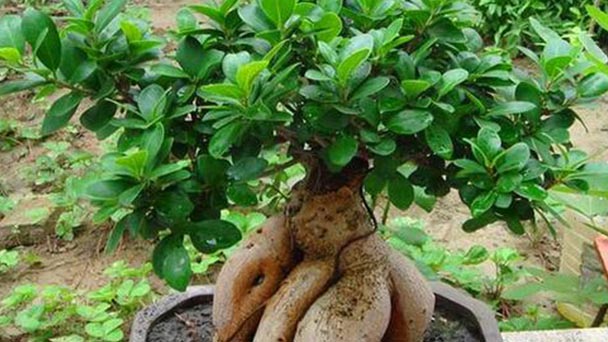How to Take Care of Ficus Microcarpa
Written by Maggie
Aug 31 2021

Ficus Microcarpa is the first choice plant for many flower lovers to raise bonsai. This plant has a very special rhizome shape, and its leaves grow very dense and luxuriant, which is very conducive to shape. But what about the blackened Ficus Microcarpa leaves that grow at home? And what if the leaves fall? How to take care of Ficus Microcarpa? Here are some caring tips.

How to care for blackening of Ficus Microcarpa leaves
1. Water Care
The occasional blackening of Ficus Microcarpa when we grow it was probably due to over watering. Ficus Microcarpa likes a wet environment, but if there is water in the soil, it will prevent the plant from receiving oxygen and nutrients, and the leaves will definitely turn black over time.
Solution: Water must be appropriate, do not appear to be a water phenomenon. If the leaves have turned black, check for root rot. If the roots have rotted, cut them off, soak them in disinfectant and replant them. Remove some of the heavy soil and add dry new soil to dilute the water.
2. Lighting Care
When the light of Ficus Microcarpa is too low, the leaves of the plant will turn black, and the plant cannot photosynthesize, which will inevitably lead to the gradual death of the leaves. However, when the leaves are exposed to the sun in summer, the leaves will turn black due to dehydration.
Solution: If the light is insufficient, it is necessary to put the right amount in the sun to bask in a sun. But if the leaves are yellow and black due to too much light, the most important thing is to replenish water, and then keep the plant in a slightly cooler environment.
3. Frostbite Care in winter
Ficus Microcarpa is not a freezing-resistant plant. During winter curing, heat preservation should be paid attention to, and it should not be put outside. If the temperature is too low, the most direct manifestation of frostbitten plants is the blackening of leaves, which will stop the growth of plants and even lead to severe freeze death.
Solution: If the leaves are black because of frostbite, it is necessary to find out whether only the leaves are frostbitten or the branches are also frostbitten. All the frostbitten parts must be cut off, then sprayed with disinfectant, and put back into the warm and sunny indoor environment for curing.If the roots are too frostbitten, it's hopeless.

How to care for Ficus Microcarpa leaf falling
Ficus Microcarpa is a very characteristic plant, with strong roots, often breaking out of the ground, thin branches, but dense leaves, and is cultivated by many flower lovers. But problems can arise in farming if you don't pay attention. What about Ficus Microcarpa falling leaves? Actually this kind of phenomenon is more because the light is insufficient, water fertilizer is overmuch, and the environment.
1. Loose soil
The looser the soil in which Ficus Microcarpa is grown, the better. Air permeability and water permeability are also important. It is best to mix river sand with peat and a little volcanic rock in a 5:4:1 ratio. Such ability lets plants absorb sufficient nutrients and moisture, prevent soil from caking even at ordinary times, often loosen a soil.
2. Water properly
Ficus Microcarpa watering quantity can not be too much or too little, keep the basin soil micro wet. It must not appear as a basin soil water phenomenon. Generally wait until the soil has dried before watering. In the spring and autumn season, maintain 3 ~ 4 days of water at once. In summer 2 ~ 3 days water once. In winter water once every 5 ~ 6 days water once.
3. Moderate temperature
Ficus Microcarpa is well suited to grow at temperatures between 18 and 33℃, and is best kept below this temperature throughout the year when conditions permit. If not, summer if the right amount of shade, for the plant to cool. But the rest of the spring, fall, and winter festivals must be sunny enough to allow Ficus Microcarpa to grow.
4. Don't change your environment
When growing Ficus Microcarpa, be careful not to move its support unless you have to. If you move, it is likely that the plant will not adapt, or even lose leaves. So choose a suitable pot plant location in the first place, preferably in an indoor place with astigmatism and good air circulation.

Latest Updated
- Benefits of Bugleweed - 7 Science-backed Health Benefits
- Bugleweed Dangers & Side Effects - Is It Poisonous?
- How to Plant Evergreen Trees - What You Should Know
- When to Plant Evergreens - Grow Guide for Evergreen Trees
- 12 Wonderful Evergreen Shrubs for Your Garden
- 12 Popular Evergreen Plants with Pictures for Beginners
- When And How To Prune A Lilac Bush Like a Pro
- How to Grow & Care for Lilac Vine (Hardenbergia Violacea)
- Japanese Lilac Tree (Syringa Reticulata) Care & Propagation Guide
- Shumard Oak Pros and Cons - What to Know
Popular Articles
- Winter maintenance of Antirrhinum Majus
- How to Grow Terminalia Mantaly Tree
- How to Grow and Care for Crossostephium Chinense
- How to grow Antirrhinum Majus in spring
- Peristeria Elata (Dove Orchid) Profile: Info & Care Guide
- Underwatered Snake Plant (Sansevieria Trifasciata) - Signs And How To Fix
- How to Care for Brazilian Jasmine Plant (Mandevilla Sanderi)
- How to Grow & Care for Graptopetalum Purple Delight in Summer
- Rosa Chinensis (China Rose): Plant Growing & Care Tips
- How to Care for Baby Sun Rose (Aptenia Cordifolia)